The Tramways of
Camagüey
BY
Allen Morrison
[ver versión en español]
The capital of Camagüey Province was called Puerto Príncipe until 1903 and is Cuba's third-largest city today. It was connected by rail to the port of Nuevitas in 1846, but was not linked by rail to Havana, 540 km northwest, until 1902 [see below]. The Nuevitas-Puerto Príncipe line was the only railroad in the West Indies that used 1600 mm gauge (it was later regauged to 1435).
Puerto Príncipe was one of the few cities in Cuba that had an animal-powered tramway – which was one of the few tramways in the world that went to war. In 1893, right before Cuba's War of Independence against Spain, a local entrepreneur named Enrique Loynaz del Castillo organized the Ferrocarril Urbano de Puerto Príncipe and ordered 12 horsecars – six passenger cars and six flat cars – from the John Stephenson Company in New York. When the shipment arrived in Cuba on 31 March 1894, the passenger cars had 200 Remington rifles and 48,000 rounds of ammunition hidden under their seats!
The first rails were laid on 3 June and the first section of the horse tramway began public service on 8 December 1894 – from the Nuevitas & Puerto Príncipe Railroad station (near the present station), down Calle Avellaneda to Plaza de la Soledad [see map]. The line was extended down Independencia and Av. de la Libertad to La Caridad on 9 February 1895. The extremely rare photograph below shows two cars at Plaza de la Caridad [El Camagüeyano, Camagüey, 24 September 1950, rotograbado section, p. 4]:
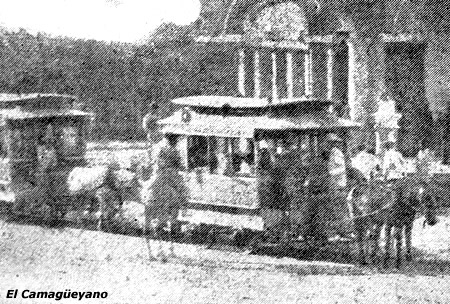
Puerto Príncipe's horse tramway survived the war years, but seems to have closed about March 1900; the rails were removed the following November. The line was commemorated in a postal cancellation a century later [col. Marcos Iglesias]:
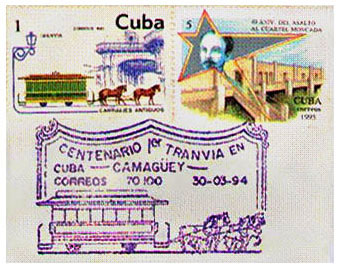
Camagüey Electric Company was registered in Halifax, Nova Scotia, in 1906. The origin of the eight toastrack cars that opened the city's electric tramway on 1 May 1908 is a mystery; no U.S. builder recorded such vehicles, so presumably they were constructed in Canada – either by carbuilder Rhodes Curry Co. in Nova Scotia or by Montreal Street Railway in Quebec, which had built electric trams for Kingston, Jamaica, in 1898. Camagüey trams 1-8 were among the very few open models in Cuba (Havana had only one specimen, Matanzas two). The postcard below shows car 5 at the railroad station on Calle Van Horne [see map] – named after the Canadian who built the railroad across eastern Cuba [col. Robert Peschkes]:
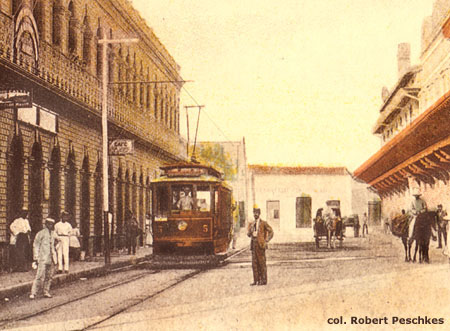
Camagüey tramway gauge was 1435 mm. In December 1908 CEC ordered a 4-axle motorized platform car, number 9, from Brill in Philadelphia. Outside Havana, this was the only known example of an 8-wheel tram in Cuba [Brill Magazine, Philadelphia, 5/1909, p. 118]:
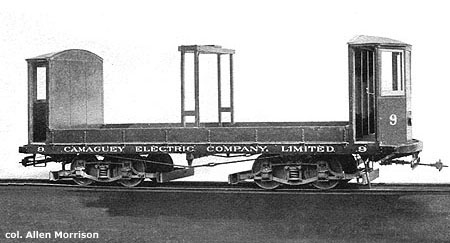
In April 1912 CEC placed another order with Brill, for four passenger cars numbered 10-13. They opened the new Bembeta route in August 1913 [see map] [Brill Magazine, Philadelphia, December 1912, p. 379]:
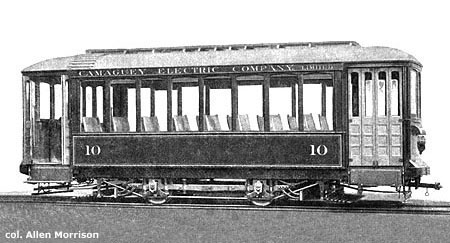
In October 1918 the Canadian company purchased another six cars from Brill, this time a strange curved-side model with a center door on only one side and controls at only one end. Single-end trams were practical in Camagüey since most routes ended in either a loop or a "Y" [see map]. The new unidirectional cars were presumably numbered 14-19. The inscription on this builder's photo suggests that they were almost shipped to Canada [col. AM]:
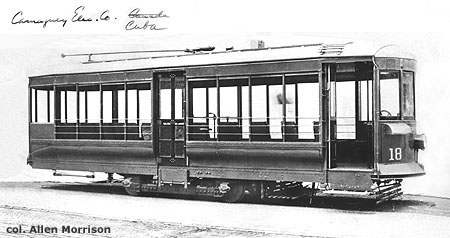
CEC inaugurated its new Garrido route on 10 October 1921 [see map] and built three center-door cars at its shops in Camagüey in 1922. CEC's electricity division was absorbed by the U.S. holding company, Electric Bond & Share, in 1923 and the tramway systems in both Camagüey and Santiago de Cuba were acquired by the Havana Electric Railway in 1926. The Havana company allowed its "División de Camagüey" to deteriorate, and after a fatal accident in 1946 the Comisión Nacional de Transportes ordered the complete rehabilitation of lines and cars. Little was done, equipment went out of service, revenues dwindled and, without pay, the workers struck. Havana Electric Railway was dissolved in 1950. The Cooperativa de Transportes de Camagüey took over operation of the failing tramway in 1951.
On 12 June 1951 U.S. transport enthusiast Francis Goldsmith visited Camagüey and photographed the trams that he saw on the streets near the railroad station. All his pictures show the same curved-side model of 1919-1922; there were no traces of the open trams of 1908 or the Brill model of 1912. Car 5 in the picture below is 32 years older but otherwise little changed from car 18 above. Since it has been renumbered, this may even be the same car. Scene is Av. de los Mártires in La Vigía [see map] [Frank Goldsmith, col. Joseph P. Saitta]:
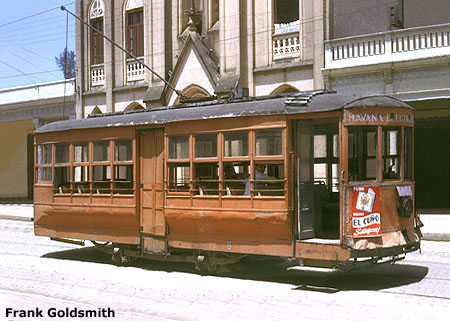
The name "Havana Electric Railway" lettered on the front of some Camagüey streetcars – like the car above – gave the impression that they had come from the capital. They had not; this was simply the name of their former owner. Car 13 below is of the same type as 5 but has had its center door moved to the rear. It is signed "Bembeta / Garrido" [see map] and was photographed on Calle República [Frank Goldsmith; reproduced with permission of www.tramway.com]:
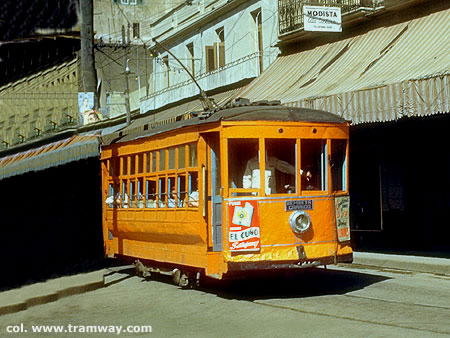
[The trams in the preceding two images were reproduced on postage stamps in 2004: see Cuban Tram Stamps.]
Car 21, below, has also had its door moved. It is signed "Libertad / Mártires" and is heading north on Calle Avellaneda toward the railroad station [see map]. The building on the right is the Hotel Plaza which faces Calle Van Horne [Frank Goldsmith, col. Joseph P. Saitta]:
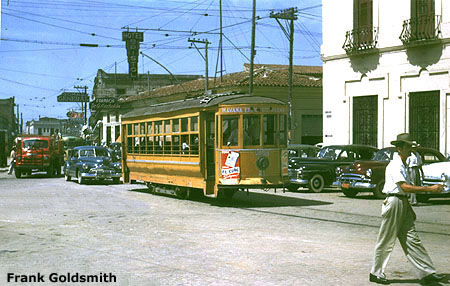
This token calls the streetcar operator "Compañía de Tranvías"; but it is not known in what period it was used [col. AM]:
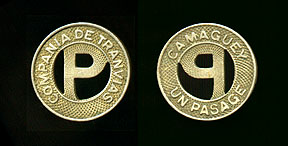
The transfer ticket below, from the period 1911-1921, notes the operator's name in English. "San Esteban" is the street called Oscar Primelles today [see map] [col. AM]:
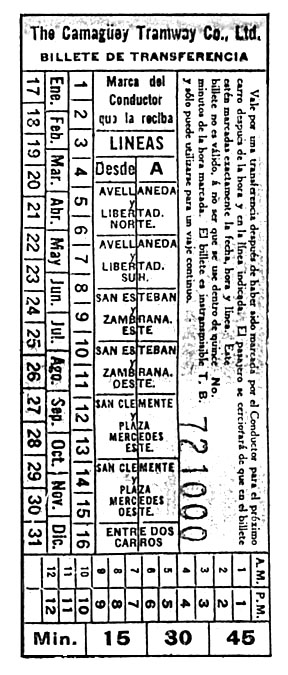
[Both the token and the transfer ticket above were copied from this webpage and reproduced on a stamp pane in 2004: see Cuban Tram Stamps.]
A short time after Mr. Goldsmith's visit, the city announced plans to replace the trams with buses. A newspaper opined [see El Camagüeyano in BIBLIOGRAPHY below]: ". . . Al despedirnos ahora de esos cómodos y seguros servidores de tantos años, como quien se despoja de un maleficio, pensemos que ellos nos han sido utilísimos en toda una época que ahora fenece" (Saying farewell to those comfortable, secure servants of so many years, like someone coming out of a dream, let us remember how useful they were to us during a long era now ending). The Camagüey tramway closed at midnight on Saturday 23 February 1952 - shortly after the tram system in Santiago and a few months before the last lines in Havana. Sixteen new gasoline buses began serving the streetcar routes the next day.
A half century later, many traces of the tramway remain. The photograph below shows the tram depot on Calle Agramonte in November 2002 [see map]. The track is still in the street:
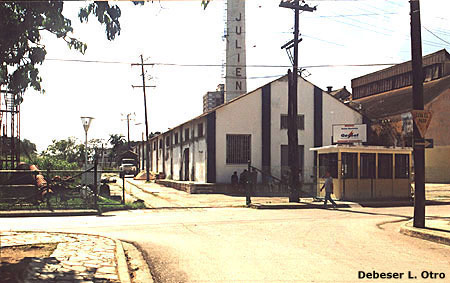
Rails can also be found along Calle Independencia, on the city's south side [see map]. The three pictures below, from the collection of Héctor Juárez Figueredo, were taken in March 2003 by Marlon Albo Alonso and Karel Alsina Angurell, students at the Universidad de Camagüey. The first view is west from Plazuela del Puente toward the tramway junction. The track is turning onto Calle Independencia:
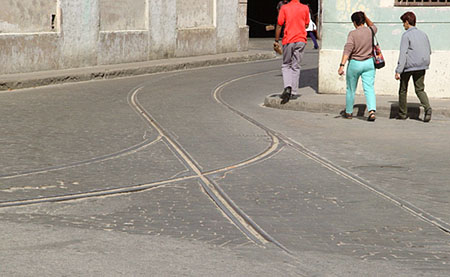
Here the photographer is looking up Calle Independencia from the curve in the photo above [see map]. Residents of these houses had to be careful stepping outside:
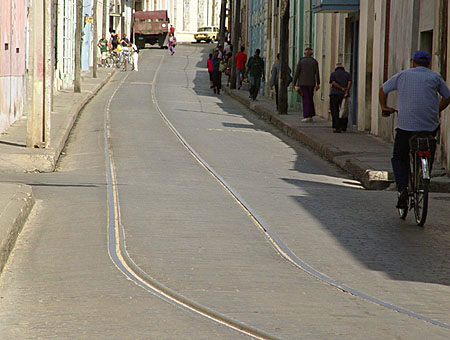
The view here is north up Independencia toward Parque Agramonte [see map]. The large white structure in the distance is the Metropolitan Cathedral, a 19th century reconstruction of the original church of 1617:
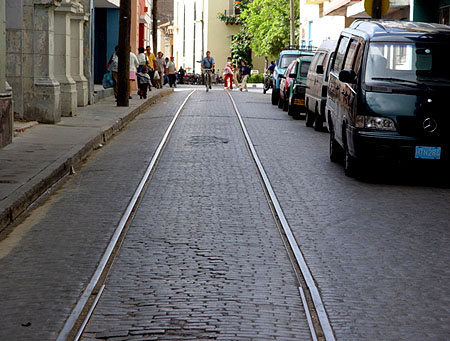
The author is indebted to Camagüey resident Héctor Juárez Figueredo for his extraordinary contributions to this page: new photographs from 2003, additional information about the old photographs, route details, the 1951 tribute, his meticulous documentation of the electric tramway's last years, his revelation of the horse tramway of 1894 – and the picture of it that he found! The author is also grateful to Marcos A. Iglesias for the postal cancellation and for the excerpts from the 1970 text cited below. Other information was gleaned from the following books, articles and maps:
BIBLIOGRAPHY (in order of publication)
"Platform Construction Car for Cuba" in Brill's Magazine (Philadelphia), May 1909, pp. 117-119. Text and two photos, including above.
"Semi-Closed Pay-Within Cars for Camagüey, Cuba" in Brill Magazine (Philadelphia), December 1912, pp. 378-381. Text, two illustrations.
Reginald Lloyd. "The Camagüey Company, Ltd." in Impresiones de la República de Cuba en el Siglo XX, pp. 482-485. London: Lloyds [sic] Greater Britain Publishing Co., 1913. Long text, mostly about finances. No illustrations.
"Welded Steel Cars in Cuba" in Electric Railway Journal (New York), 18 February 1922, p. 276. Description and three illustrations of the curved-side trams built by the Camagüey tramway in Cuba.
Jorge Juárez Cano. Apuntes de Camagüey. Camagüey: El Popular, 1929. Notes on the 1894 horse tramway, pp. 196-198.
Benito A. Rodríguez. Plano de la Ciudad de Camagüey. Camagüey, 1931. Nice street map shows tram lines. Basis for the map of this website.
News items about the tramway's final struggle in El Camagüeyano (Camagüey) of 27/6, 5/7 & 22/9/1946; 20/7, 26-27/7, 19/8, 26/8, 28/8, 30/8 & 30/10/1950; 3/1, 16/1, 7/3, 17/4, 21/4, 1/5, 13/9 & 5/12/51; and 10/1, 3/2, 23/2 & 24/2/1952.
Juan Marigó Millas. "Guaguas vs. tranvías" in El Camagüeyano (Camagüey), 2/11/1951, p. 8. Tribute to the disappearing streetcars of Camagüey.
Academia de Ciencias de Cuba. Indice Histórico de la Provincia de Camagüey. Havana: Organismos, Instituto Cubano del Libro, 1970. Tramway references on pp. 37-38, 47, 54, 83, 100, 103, 202, 309 and 313.
Gustavo Sed Nieves. "Un tranvía de tracción animal" in Adelante (Camagüey), 21/9/1971, p. 2. Good technical data. The only text that specifies John Stephenson as the builder of the horsecars.
return to
INTRODUCTION & INDEX MAP
Copyright © 2002-2102 Allen Morrison - ALL RIGHTS RESERVED
|





























